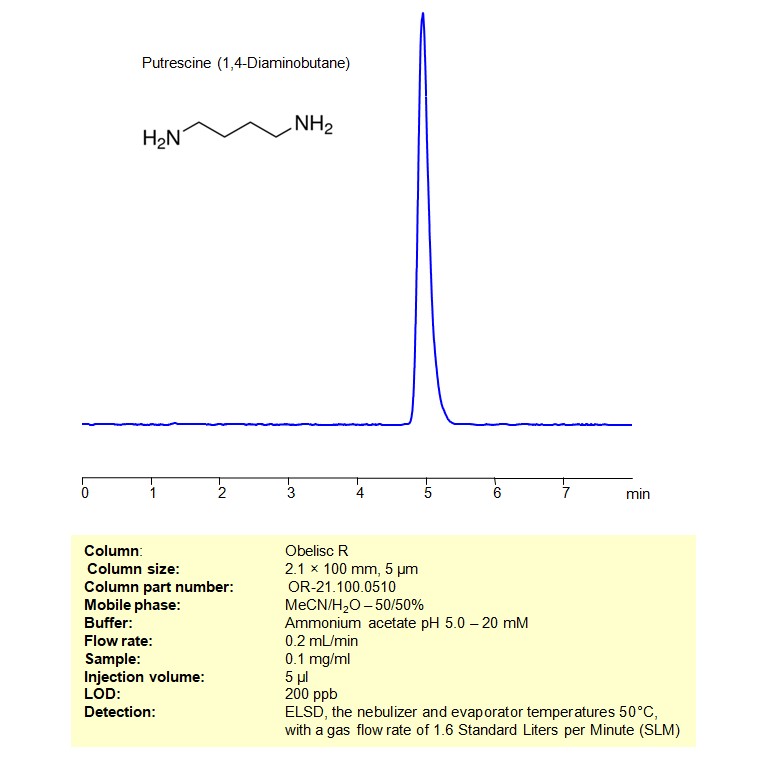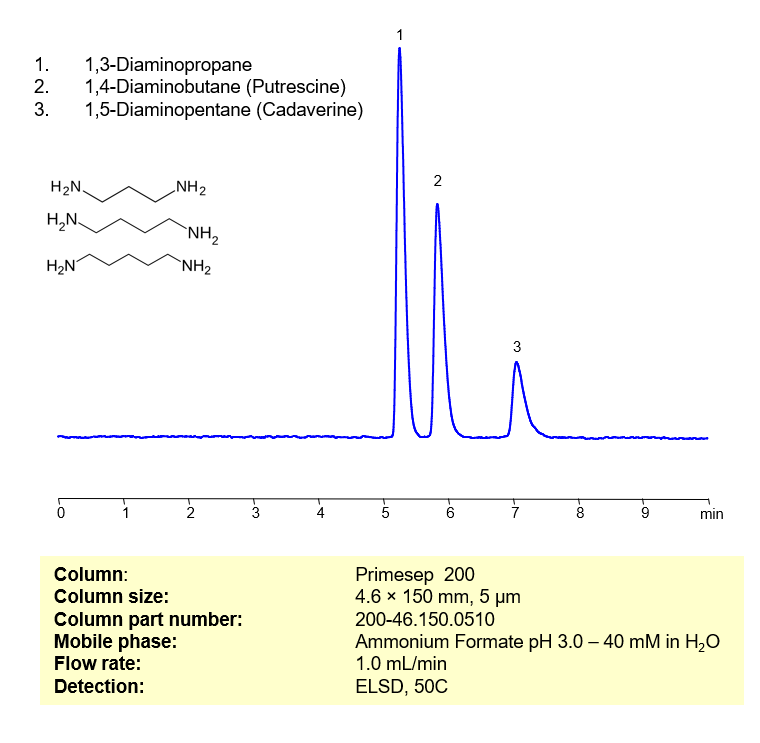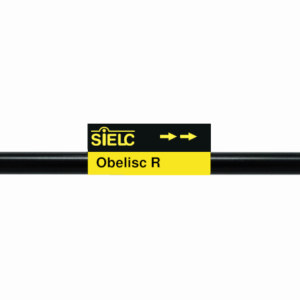
| CAS Number | 110-60-1 |
|---|---|
| Molecular Formula | C4H12N2 |
| Molecular Weight | 88.15 |
| InChI Key | KIDHWZJUCRJVML-UHFFFAOYSA-N |
| LogP | 0.1 |
| Synonyms |
|
Applications:
HPLC ELSD Method for Analysis Putrescine on Obelisc R Column
February 1, 2024
HPLC Method for Analysis of 1,4-Diaminobutane (Putrescine) on Obelisc R by SIELC Technologies

High Performance Liquid Chromatography (HPLC) Method for Analysis of 1,4-Diaminobutane (Putrescine)
Putrescine is a biogenic amine and organic compound with the chemical formula. It is a polyamine, which means it contains multiple amino groups. Putrescine is one of the naturally occurring polyamines found in living organisms and is involved in various biological processes.
Biological Roles:
- Putrescine is involved in cell growth, proliferation, and differentiation.
- It plays a role in the synthesis of other important molecules, including certain alkaloids and polyamine derivatives.
- Putrescine is produced by the decarboxylation of ornithine, an amino acid.
Polyamine Family:
- Putrescine is part of a family of polyamines, which also includes spermidine and spermine.
- Polyamines are essential for cell growth, and their levels are tightly regulated in living cells.
Research and Applications:
- Putrescine and other polyamines have been studied for their roles in cancer, neurodegenerative diseases, and other health-related conditions.
- In some industries, putrescine is used as a chemical intermediate for the production of certain polymers and plastics.
Putrescine can be retained and analyzed using an Obelisc R mixed-mode stationary phase column. The analysis employs an isocratic method with a simple mobile phase consisting of water, acetonitrile (MeCN), and ammonium formate as a buffer. Detection is achieved using ELSD
| Column | Obelisc R, 2.1 x 100 mm, 5 µm, 100 A, dual ended |
| Mobile Phase | MeCN/H2O – 50/50% |
| Buffer | Ammonium formate pH 3.0 – 20 mM |
| Flow Rate | 0.2 ml/min |
| Detection | ELSD, the nebulizer and evaporator temperatures 50°C, with a gas flow rate of 1.6 Standard Liters per Minute (SLM) |
| Samples | 0.1 mg/ml |
| Injection volume | 5 µl |
| LOD* | 200 ppb |
| Class of Compounds | Polyamines |
| Analyzing Compounds | 1,4-Diaminobutane (Putrescine) |
Application Column
Obelisc R
Column Diameter: 2.1 mm
Column Length: 100 mm
Particle Size: 5 µm
Pore Size: 100 A
Column options: dual ended

HPLC Method Separation of 1,3-Diaminopropane, 1,4-Diaminobutane (Putrescine) and 1,5-Diaminopentane (Cadaverine) on Primesep 200 Column
March 24, 2023
HPLC Method for Analysis of 1,5-Diaminopentane (Cadaverine), 1,3-Diaminopropane, 1,4-Diaminobutane (Putrescine) on Primesep 200 by SIELC Technologies
Separation type: Liquid Chromatography Mixed-mode

1,3-Diaminopropane, or trimethylenediamine, is a key heterocycle building block and precursor of the chemotherapy antineoplastic agents Prioxantrone and Losoxantrone. 1,4-Diaminobutane, or Putrescine, is one of the main sources of the foul odor of rotting flesh, but has found use as a building block of Nylon 46. 1,5-Diaminopentane, or Cadaverine, is another source of the foul odor of rotting flesh and since its produced by the decarboxylation of lysine, can be used as a biomarker for lysine metabolic deficiencies.
These (putrid) diamines can be retained, analyzed, and separated on a Primesep 200 column using an isocratic analytical method with a simple mobile phase of water, Acetonitrile (MeCN), and an Ammonium formate (AmFm) ionic modifier. This analysis method can be detected with an Evaporative Light Scattering Detector (ELSD) or any other evaporative detection method (CAD, ESI-MS).
High Performance Liquid Chromatography (HPLC) Method for Analysis of 1,5-Diaminopentane (Cadaverine), 1,3-Diaminopropane, 1,4-Diaminobutane (Putrescine)
Condition
| Column | Primesep 200, 4.6 x 100 mm, 5 µm, 100 A, dual ended |
| Mobile Phase | H2O |
| Buffer | Ammonium formate pH 3.0 – 40 mM |
| Flow Rate | 1.0 ml/min |
| Detection | ELSD, 50C |
| Peak Retention Time | 5.2, 5.8, 7.2 min |
Description
| Class of Compounds | Diamino |
| Analyzing Compounds | 1,5-Diaminopentane (Cadaverine), 1,3-Diaminopropane, 1,4-Diaminobutane (Putrescine) |
Application Column
Primesep 200
Column Diameter: 4.6 mm
Column Length: 100 mm
Particle Size: 5 µm
Pore Size: 100 A
Column options: dual ended
1,4-Diaminobutane (Putrescine)
1,5-Diaminopentane (Cadaverine)



